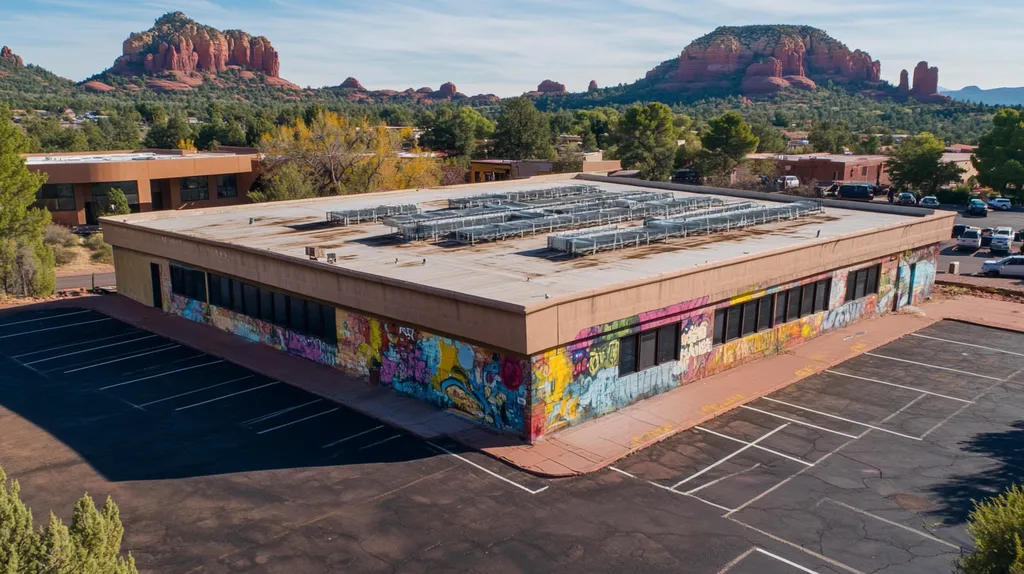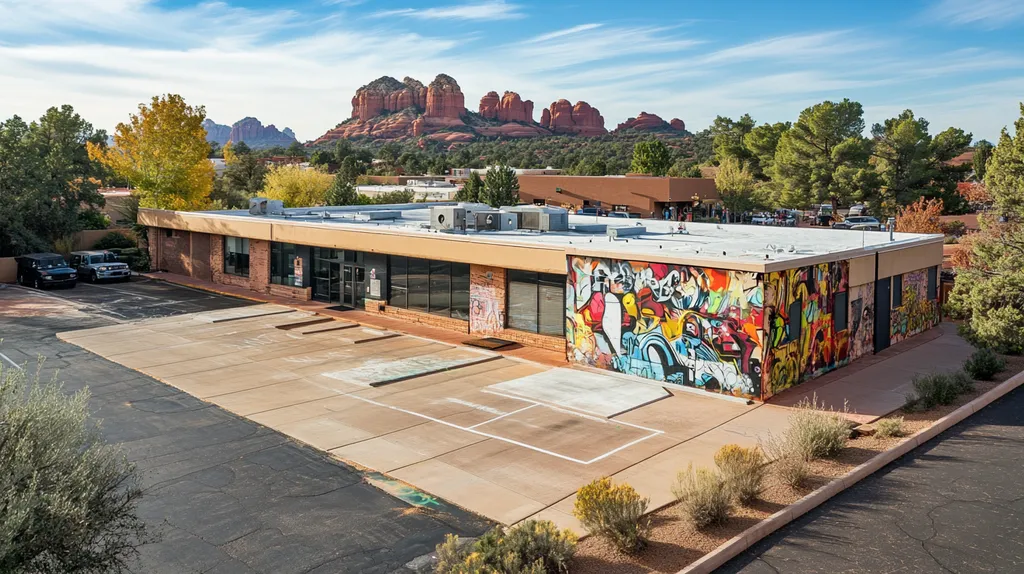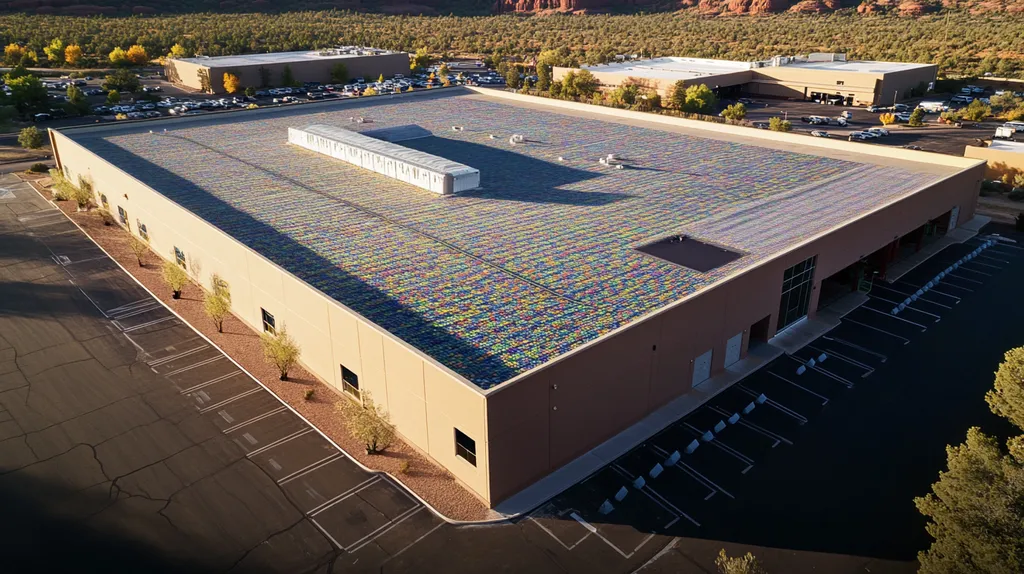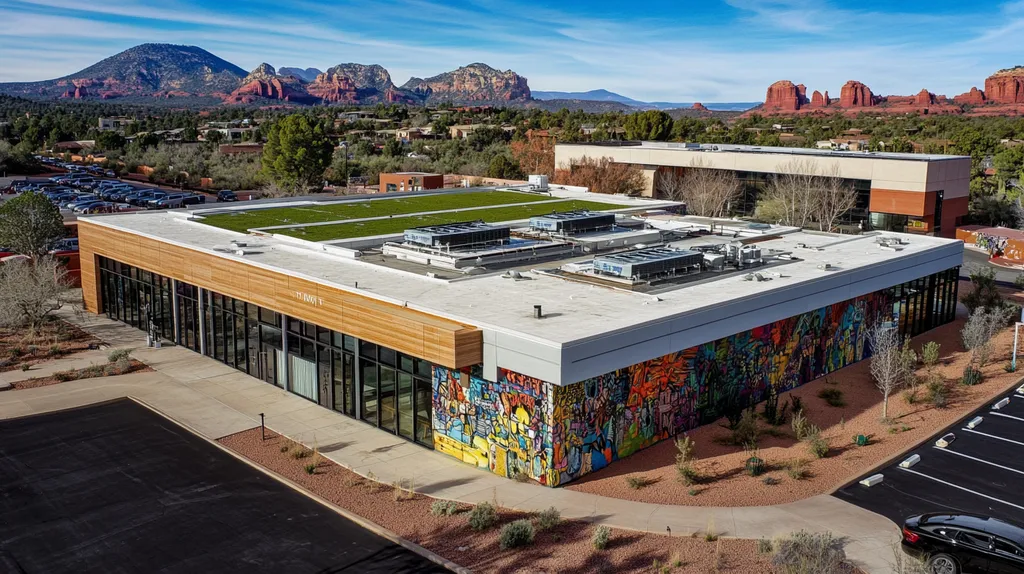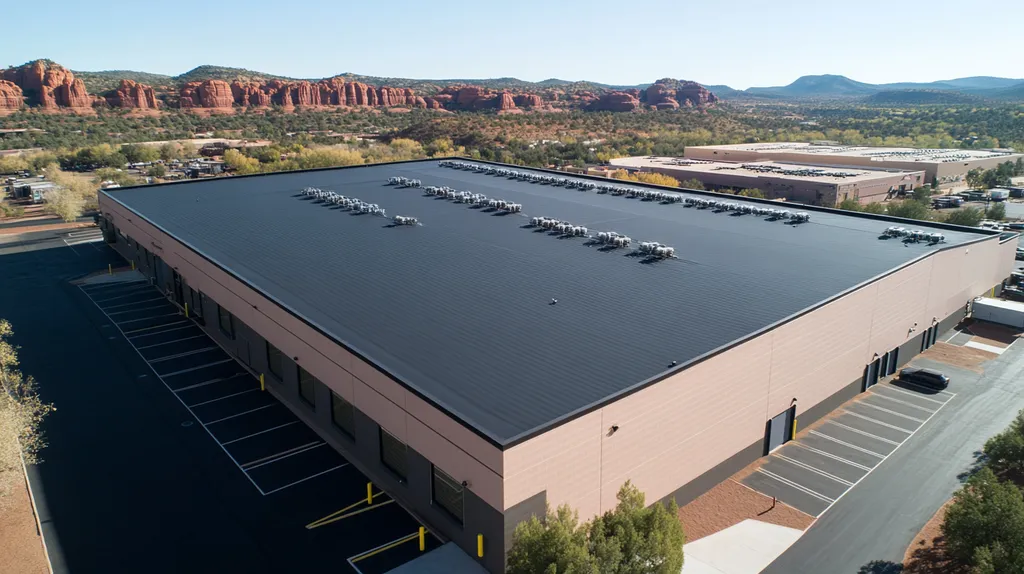For commercial property owners, heat isn’t just an environmental factor—it’s a silent adversary that can slash a roof’s lifespan by up to 45% while inflating energy costs by thousands annually.
As global temperatures continue to rise, understanding heat’s impact on commercial roofing has become more critical than ever for protecting these substantial investments.
From material degradation and thermal shock to compromised structural integrity, heat-related challenges pose significant risks to both building performance and bottom lines.
This comprehensive guide examines the crucial factors affecting roof longevity and efficiency, offering practical solutions for property owners and facility managers seeking to maximize their roofing investments in an increasingly warming world.
SECTION 1: THE BASICS EXPLAINED
The effects of heat on commercial roofs are often overlooked, yet they are crucial for extending the life and efficiency of these critical structures. As global temperatures rise and energy costs continue to climb, understanding heat’s impact has never been more vital. A roof that falls victim to heat can lead to premature failures, costly repairs, and potential safety risks for those inside the building. By grasping how heat influences roofing systems, property owners and facility managers can safeguard their investments.
What It Is (In Plain Language)
Heat is the invisible force that raises the temperature of the roof surface and its materials. This energy comes from sources like direct sunlight, surrounding air temperatures, and even from the building’s own machinery. When roofs soak up this heat, a variety of issues can arise.
For example, roofing materials tend to expand and contract as temperatures fluctuate. This constant stretching and shrinking unavoidably leads to stress, resulting in cracks and splits. As these issues take hold, they threaten the roof’s overall integrity, increasing the risk of leaks.
Moreover, heat can wear down roofing materials over time, particularly those of lower quality. Understanding this deterioration process is essential for making the right choices when selecting a roofing system for any commercial property.
This knowledge not only aids in material selection but also ensures effective planning for maintenance and repairs.
Why It Matters (To Your Building)
The impact of heat on roofing directly affects both the operational costs and longevity of a building. A roof that fails prematurely due to heat exposure can result in expensive repairs that disrupt day-to-day business activities.
A well-maintained roof acts as a protective layer, preventing leaks and prolonging its lifespan. This is especially crucial for commercial properties, where even minor downtime can hit revenue and customer satisfaction hard.
Additionally, roofs that can handle heat more effectively lead to increased energy efficiency. Buildings boasting such roofs require less cooling, which translates to lower utility bills and a smaller carbon footprint.
Therefore, understanding the thermal dynamics involved can significantly impact both a building’s financial performance and environmental responsibilities.
How It Works
The dynamic between heat and roofing materials is shaped by intricate physical processes, including thermal expansion and material degradation. When temperatures rise, roofing materials like asphalt, membrane, and metal expand, potentially causing warping or buckling.
Extended heat exposure can also degrade roofing membranes and sealants, setting the stage for early failure. This degradation often shows up as cracks, tears, or loss of adhesion, leading to leaks down the line.
It’s also essential to consider the role of reflective coatings. These special finishes can help reduce heat absorption, keeping roof temperatures lower. Not only does this extend the roof’s life, but it can also significantly decrease cooling costs.
Understanding these processes equips property owners and managers with the insights needed to implement preventative strategies that boost roof performance and longevity.
SECTION 2: PRACTICAL APPLICATIONS
The choices property owners make about their roofing can dramatically influence both its lifespan and the building’s overall energy efficiency. With heat levels rising and the potential impacts intensifying, grasping how heat interacts with roofing materials is more crucial than ever. For instance, roofs that endure high temperatures are prone to thermal expansion, which can lead to cracks and leaks—resulting in a spike in repair costs. This section examines the diverse applications of roofing materials, spotlights critical moments when heat effects are most pronounced, and explores how roofing systems engage with other building components.
Common Uses & Examples
Commercial roofs are more than mere overheads; they perform essential roles from safeguarding inventory to supporting HVAC systems. For example, flat membranes are frequently employed in warehouses, offering durability and energy efficiency—particularly important, given their susceptibility to heat accumulation.
Materials vary in their reactions to heat. Single-ply membranes, like TPO and PVC, are favored for their reflective capabilities, which significantly reduce heat absorption. Conversely, traditional built-up roofs often absorb heat, inflating cooling costs and leading to greater energy consumption.
In regions that experience extreme heat, opting for cool roofing solutions can translate to substantial savings on energy bills. It’s vital for facilities managers to weigh the long-term benefits of reflective roofing when considering options to mitigate heat damage.
Ultimately, making informed choices about roofing materials based on their heat resistance is a pivotal factor in boosting the roof’s longevity and overall performance.
When You Need It Most
Summer months are when heat exposure reaches its zenith, putting roofs under duress and exacerbating wear and tear. Consequently, regular inspections become indispensable during this time. Property owners should plan roof evaluations both before and after peak summer to identify any hidden damage.
The orientation of the building also matters. Roofs that bask in the sun longer endure wear and tear more rapidly than those shaded. This detail is particularly significant for facilities located in hot climates, where sun exposure can exacerbate heat-related challenges.
Moreover, thermographic inspections can be instrumental in pinpointing heat retention and vulnerabilities within the roofing system. These advanced methods can identify areas that necessitate urgent repair or reinforcement, warding off costly leaks and failures in the future.
Tackling heat impacts proactively is critical for preserving the integrity of any commercial roof.
Interactions With Other Systems
Commercial roofs don’t operate in a vacuum; they are intertwined with other building systems. For instance, heating, ventilation, and air conditioning (HVAC) systems depend on a well-functioning roof to work efficiently. Excessive heat absorbed by roofing materials means HVAC systems may operate harder, increasing energy use.
Insulation, too, plays a vital role in regulating heat effects. Quality insulation curtails heat transfer, keeping indoor temperatures comfortable. Property owners should assess their insulation during routine roof inspections since insufficient insulation could lead to energy inefficiencies that speed up roof deterioration.
Proper drainage systems are equally crucial in managing water runoff, particularly during extreme heat events that induce materials to expand and contract. Poor drainage can lead to standing water, escalating roof damage and associated costs.
Grasping how these systems interact under heat stress is essential for minimizing maintenance expenditures and enhancing energy efficiency.
SECTION 3: KEY TERMINOLOGY DECODED
Grasping the terminology related to commercial roofing is not just useful—it’s essential for avoiding costly blunders. Misunderstanding key concepts like R-value and U-value can affect energy efficiency and longevity, leading to financial headaches. This section breaks down important roofing terms, clarifies industry lingo, and demystifies measurement units crucial for assessing how heat impacts roof performance.
Essential Terms Explained
Let’s start with R-value, a reflection of thermal resistance that tells you how well a roofing material insulates against heat flow. A higher R-value translates to better insulation, which can significantly enhance energy efficiency. In contrast, U-value measures how much heat passes through a building element, providing insights into energy loss. Familiarity with these concepts helps property owners choose materials suited to their climate and building design.
Another pivotal term is “solar reflectance,” representing a material’s ability to bounce sunlight away. Higher solar reflectance means lower roof surface temperatures, which mitigates heat absorption and extends the roof’s lifespan. Similarly, “thermal emittance” refers to how effectively a material releases absorbed heat, optimizing both properties helps prevent heat buildup and improves overall energy efficiency.
Lastly, “cool roofing” describes materials specifically designed to reflect more sunlight and absorb less heat. Incorporating cool roofing solutions can substantially lower surface temperatures, enhancing both thermal performance and energy costs. Being conversant with these terms is indispensable for understanding how heat influences the durability and efficiency of commercial roofing systems.
Industry Jargon Translated
Roofing jargon can be a minefield for the uninitiated. Terms such as “blistering” and “ponding” highlight common issues stemming from heat exposure. Blistering occurs when moisture trapped in roofing materials heats up and forms bubbles, compromising structural integrity. Ponding refers to water pooling on flat roofs; this condition worsens with heat and can severely damage the roof if left unaddressed.
Other terms like “asphalt saturation” and “single-ply membrane” also deserve attention. Asphalt saturation is the process of impregnating roofing materials with asphalt to boost durability. Single-ply membranes are flexible sheets that resist heat-related damage, offering excellent protection against roof deterioration. Familiarity with these terms enhances communication with contractors, ensuring clearer and more productive discussions around roofing projects.
Comprehending this jargon is key for making informed choices. Misunderstandings can lead to incorrect product selections and ineffective maintenance strategies, which can adversely affect roof performance and longevity. A solid grasp of these terms lays the groundwork for better management of commercial roofing systems.
Measurement & Units Simplified
Measurements in roofing often come in specific units that can seem intimidating. For example, square footage measures roof area and is essential for calculating how much material is needed. Accurate square footage helps prevent overages or shortages, which can impact costs and installation quality.
Temperature readings are typically presented in degrees Fahrenheit (°F) or Celsius (°C). Understanding these temperature measures allows property owners to pinpoint and address potential heat-related issues in roofing systems. For instance, temperature fluctuations can warp materials or cause premature failure if not managed properly.
Another crucial unit is the “ASTM” rating, a standard that assesses roofing materials’ resistance to fire, wind, and heat. Being familiar with ASTM ratings offers insights into how well materials will perform under thermal stress. Knowledge of these standards equips facility managers to make informed choices, ensuring their roofs stand the test of time.
SECTION 4: DECISION FACTORS
Making thoughtful decisions about roofing systems is critical for commercial and industrial property owners today. As global temperatures climb higher, the choice of roofing can have a profound effect on maintenance costs, energy efficiency, and the overall lifespan of a building. A roof that fails to cope with heat effectively often experiences premature deterioration, leading to costly repairs. Understanding the cost considerations, performance trade-offs, and durability factors is essential for maximizing a roof’s lifespan and ensuring it stands the test of time.
Cost Considerations
Cost is usually top of mind for property owners when selecting a roofing system. While the initial installation price is often appealing, it’s crucial to also consider the long-term expenses. A roof that fails to manage heat effectively can result in significantly higher cooling costs. By investing a bit more upfront in reflective materials, property managers might find their energy bills and roof lifespan improving dramatically.
Take flat roofs, for example: they tend to absorb heat more readily. Opting for higher-quality materials, such as single-ply membranes with reflective coatings, can cut cooling costs by as much as 20% annually, making the initial investment worthwhile.
Additionally, maintenance costs can soar when roofs suffer from heat-related damage. The savings realized from a durable, heat-resistant roof often far outweigh the initial price tag. Thus, evaluating the total cost of ownership instead of only the sticker price is vital.
Finally, don’t underestimate the value of warranties. Higher-quality roofs frequently come with longer warranties, providing peace of mind against unforeseen repair costs as time marches on.
Performance Trade-offs
Performance trade-offs must be factored in alongside cost. Not every roofing material manages heat effectively; some may shine in durability but lag in energy efficiency. For instance, traditional asphalt roofs might come at a lower price, but they tend to trap heat, resulting in discomfort and elevated energy usage.
In contrast, reflective roofing systems, like advanced white membranes, may require a higher initial investment but excel in thermal management. These systems not only reflect sunlight but can keep indoor temperatures cooler, boosting occupant comfort significantly.
Performance considerations go beyond immediate savings, too. Selecting the right roofing materials can mitigate the thermal expansion caused by heat, thereby minimizing stress on seams and joints. Striking the right balance between cost, durability, and performance can lead to optimal long-term outcomes.
Ultimately, achieving the perfect equilibrium between cost and performance can greatly affect a building’s environmental footprint. Choosing eco-friendly materials can create advantageous trade-offs in energy use, waste management, and overall building performance.
Lifespan & Durability Factors
Lifespan is a vital consideration tied directly to material selection, particularly in the face of heat exposure. Roofs unable to withstand high temperatures tend to age more rapidly, leading to increased repair or replacement needs. Choosing materials designed for intense conditions—like modified bitumen or TPO—can greatly enhance the longevity of the roof.
Another key durability aspect is how well the roof resists UV rays, which can lead to material degradation over time. Implementing protective coatings can boost a roof’s solar reflectivity, consequently extending its lifespan by several years.
Local climate conditions also significantly influence material choice. Roofs in hotter climates may require different materials or insulation strategies compared to those in milder environments. Understanding local weather patterns and selecting materials designed to withstand those conditions are crucial for performance and durability.
Lastly, regular inspections and maintenance of the roofing system cannot be overlooked. Routine assessments help identify heat-related damage early and allow for timely interventions, keeping the roof’s lifespan intact and saving significant costs further down the road.
SECTION 5: COMMON CHALLENGES
Heat isn’t just a minor inconvenience for commercial roofs; it can be a major culprit behind costly repairs and premature replacements. In fact, over 60% of roofing failures are linked to heat exposure, according to a study by the National Roofing Contractors Association. Recognizing common heat-related challenges is crucial for property owners and facility managers striving to maintain both roof longevity and efficiency.
Frequent Problems & Solutions
The challenges posed by heat are numerous and formidable. One notable issue is blistering, where moisture trapped beneath the roofing membrane expands and bubbles up in the heat. The good news? Ensuring proper drainage and ventilation can go a long way in addressing this problem, effectively allowing heat and moisture to escape.
Another common conundrum is the premature aging of roofing materials. For instance, single-ply membranes can warp under the relentless sun. Implementing reflective roofing solutions can offer a smart solution, bouncing sunlight away and lowering surface temperatures to counteract this issue.
Regular inspections also play a vital role in catching these problems before they escalate. Scheduling biannual evaluations allows property owners to monitor for signs of heat damage, ensuring timely repairs that can significantly extend the roof’s lifespan.
Ultimately, a proactive maintenance strategy combined with informed solutions can substantially mitigate heat-related challenges and enhance the resilience of roofing structures.
Warning Signs To Watch For
Identifying warning signs early can save property owners from extensive roof damage and expensive repairs. Keep an eye out for curled or cracked roofing materials; these often indicate thermal stress. Acting quickly, whether through patching or reinforcement, can help prevent further complications down the line.
Moisture intrusion is another red flag. If dark spots or stains appear on ceilings or walls, this may indicate membrane failure due to heat exposure. Promptly addressing leaks and replacing damaged areas is crucial to minimize long-term impacts on the property.
Increased energy consumption can also hint at insulation problems caused by heat, suggesting that roofing insulation may be compromised. Upgrading insulation or considering cool roofing systems can significantly enhance energy efficiency and lessen heat’s harmful effects.
Being vigilant about these warning signs enables property owners to take timely actions, preserving both the roof’s integrity and the overall building performance.
Preventative Approaches
Taking preventative measures can effectively counteract heat-related challenges. Routine maintenance, such as cleaning gutters and drains, is essential to ensure proper drainage and prevent trapped heat and moisture from exacerbating thermal fluctuations.
Investing in reflective roofing materials is another robust strategy. These materials significantly reduce heat absorption, keeping roof temperatures lower and mitigating the effects of thermal expansion. Options like white membranes or specialized coatings can be prime considerations.
Scheduled inspections are vital for addressing wear and tear before they escalate into significant issues. Engaging professional roofing contractors for regular evaluations ensures timely intervention, protecting the roof’s integrity over the long haul.
Lastly, empowering facility managers with knowledge about heat’s impacts fosters informed decision-making in repairs and upgrades. After all, knowledge is a powerful ally in extending the lifespan of commercial roofs.
SECTION 6: NEXT STEPS & RESOURCES
Understanding how heat impacts commercial roofs isn’t just an academic exercise—it’s essential for safeguarding investments and ensuring efficiency. Ignoring this critical aspect can lead to financial losses and safety hazards, with studies showing roofs can lose up to 75% of their insulation effectiveness due to relentless heat exposure. Property owners and facility managers must actively seek solutions and resources to combat these risks. This section highlights essential steps to take and valuable resources at your disposal.
Questions To Ask Providers
In the competitive arena of commercial roofing, selecting the right provider is paramount. Start by asking about the materials they use, specifically their heat-resistance ratings. A reputable contractor will back their claims with data showing how their products perform under elevated temperatures.
Don’t forget to inquire about warranties for both materials and workmanship. A robust warranty acts as a safety net against the inevitable wear that heat inflicts. It’s also wise to ask about tailored maintenance plans for extreme weather, as proactive care can vastly prolong a roof’s lifespan.
Additionally, determine if the provider employs reflective coatings to minimize heat gain. These innovative solutions can significantly lower rooftop temperatures and enhance energy efficiency. Finally, explore their experience with retrofitting existing roofs, as it can lead to cost-effective strategies for improving heat management.
Industry Standards & Guidelines
Staying updated on industry standards is integral to ensuring that commercial roofs are equipped to resist heat damage effectively. The American Society for Testing and Materials (ASTM) establishes guidelines for materials and methods used in roof installations. Property owners should pay close attention to ASTM E1980, which focuses on solar reflectance and thermal emittance of roofing materials.
The Cool Roof Rating Council (CRRC) also offers resources for identifying cool roofing products that excel in solar reflectivity. Adhering to these standards can considerably boost energy efficiency and extend roof life. Facility managers must also ensure compliance with local regulations concerning energy efficiency.
Regularly reviewing these standards enables property owners to align their roofing investments with best practices in the industry. Staying informed about evolving guidelines paves the way for improving asset management throughout a roof’s lifecycle.
Further Learning Simplified
Knowledge is indeed power, especially in the realm of roofing. An array of resources is available for property owners and facility managers eager to dive into heat management strategies. Websites like the National Roofing Contractors Association (NRCA) offer a wealth of articles, webinars, and training modules focused on best practices for heat resistance.
Trade publications are yet another treasure trove, filled with case studies that illustrate the repercussions of heat on various roofing systems. These resources frequently provide expert advice on selecting the right materials and technologies. Attending industry trade shows is a great way to connect directly with top manufacturers and discover innovative roofing solutions.
Investing time in local workshops or training sessions led by roofing professionals can significantly enrich understanding. These hands-on experiences allow property owners to ask questions and receive tailored guidance relevant to their specific needs.
The Bottom Line
With commercial roofs losing up to 45% of their expected lifespan due to heat damage, the stakes for proper heat management have never been higher.
As global temperatures continue to climb, property owners who fail to address heat’s impact face accelerated deterioration, soaring energy costs, and premature roof replacement—often decades before expected.
The good news? Armed with proper knowledge of materials, preventative maintenance, and modern heat-mitigation technologies, facilities managers can extend roof lifespans by 15-20 years while reducing cooling costs by up to 25%.
The message is clear: in today’s warming climate, treating heat as a critical factor in roofing decisions isn’t just smart business—it’s essential for protecting valuable commercial assets.
FREQUENTLY ASKED QUESTIONS
Q. How does heat affect commercial roof longevity?
A. Heat causes roofing materials to expand and contract, leading to stress and potential cracks. Over time, this can weaken the roof’s integrity and increase repair needs. Understanding these effects helps property owners choose better materials and maintenance plans.
Q. What types of commercial roofs handle heat better?
A. Reflective roofing materials, such as TPO and PVC, are designed to deflect heat. These options not only prolong the roof’s lifespan but also reduce cooling costs significantly. Choosing the right material plays a crucial role in maintaining roof performance.
Q. What are key terms related to heat impact on roofs?
A. Important terms include R-value, which measures insulation effectiveness, and solar reflectance, indicating a material’s ability to reflect sunlight. Understanding these concepts ensures property owners can make informed material selections that combat heat effectively.
Q. How can property owners mitigate heat damage on roofs?
A. Implementing regular maintenance and inspections can catch issues before they worsen. Additionally, opting for reflective roofing materials and ensuring proper ventilation can significantly lower heat accumulation, protecting the roof’s integrity over time.
Q. What are common warning signs of heat-related roof damage?
A. Look for curled or cracked materials and water stains inside the building. These signs often indicate thermal stress or moisture intrusion. Addressing these issues quickly can prevent greater damage and costly repairs.
Q. What should I ask a contractor about roofing systems?
A. Inquire about the materials they use and their heat-resistance ratings. Understanding warranties, maintenance plans, and experience with reflective coatings also ensures you choose a knowledgeable provider that aligns with your needs.
Q. How can I further educate myself on roofing and heat management?
A. Explore resources from the National Roofing Contractors Association, attend industry seminars, and read trade publications. Engaging in these activities enriches your understanding of effective heat management and current roofing practices.

